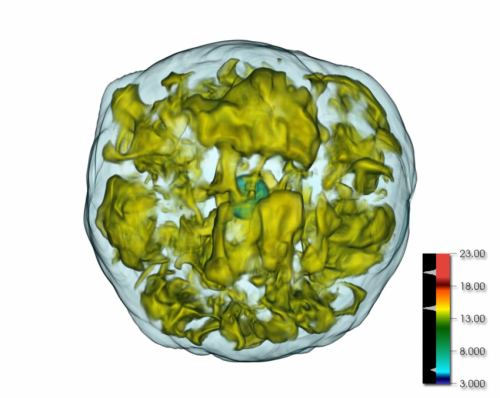Simulated 'engine of explosion' observed in supernova remnant

Back in 2003, researchers using the Oak Ridge Leadership Computing Facility's (OLCF's) first supercomputer, Phoenix, started out with a bang. Astrophysicists studying core-collapse supernovae—dying massive stars that violently explode after running out of fuel—asked themselves what mechanism triggers explosion and a fusion chain reaction that releases all the elements found in the universe, including those that make up the matter around us?
"This is really one of the most important problems in science because supernovae give us all the elements in nature," said Tony Mezzacappa of the University of Tennessee-Knoxville and researcher at the time at DOE's Oak Ridge National Laboratory.
Leading up to the 2003 simulations on Phoenix, one-dimensional supernovae models simulated a shock wave that pushes stellar material outward, expanding to a certain radius before, ultimately, succumbing to gravity. The simulations did not predict that stellar material would push beyond the shock wave radius; instead, infalling matter from the fringes of the expanding star tamped the anticipated explosion. Yet, humans have recorded supernovae explosions throughout history.
"There have been a lot of supernovae observations," Mezzacappa said. "But these observations can't really provide information on the engine of explosion because you need to observe what is emitted from deep within the supernova, such as gravitational waves or neutrinos. It's hard to do this from Earth."
Then simulations on Phoenix offered a solution: the SASI, or standing accretion shock instability, a sloshing of stellar material that destabilizes the expanding shock and helps lead to an explosion.
"Once we discovered the SASI, it became very much a part of core-collapse supernova theory," Mezzacappa said. "People feel it is an important missing ingredient."
The SASI provided a logical answer supported by other validated physics models, but it was still theoretical because it had only been demonstrated computationally.
Now, more than a decade later, researchers mapping radiation signatures from the Cassiopeia A supernova with NASA's NuSTAR high-energy x-ray telescope array have published observational evidence that supports the SASI model.
"What they're seeing are x-rays that come from the radioactive decay of Titanium-44 in Cas A," Mezzacappa said.
Because Cassiopeia A is only 11,000 light-years away within the Milky Way galaxy (relatively nearby in astronomical distances), NuSTAR is capable of detecting Ti-44 located deep in the supernova ejecta. Mapping the radiative signature of this titanium isotope provides information on the supernova's engine of explosion.
"The distribution of titanium is what suggests that the supernova 'sloshes' before it explodes, like the SASI predicts," Mezzacappa said.
This is a rare example of simulation predicting a physical phenomenon before it is observed experimentally.
"Usually it's the other way around. You observe something experimentally then try to model it," said the OLCF's Bronson Messer. "The SASI was discovered computationally and has now been confirmed observationally."
The authors of the Nature letter that discusses the NuSTAR results cite Mezzacappa's 2003 paper introducing the SASI in The Astrophysical Journal, which was coauthored by John Blondin and Christine DeMarino, as a likely model to describe the Ti-44 distribution.
Despite observational support for the SASI, researchers are uncertain whether the SASI is entirely responsible for triggering a supernova explosion or if it is just part of the explanation. To further explore the model, Mezzacappa's team, including the Innovative and Novel Computational Impact on Theory and Experiment (INCITE) project's principal investigator Eric Lentz, are taking supernovae simulations to the next level on the OLCF's 27-petaflop Titan supercomputer located at Oak Ridge National Laboratory.
"The role of the SASI in generating explosion and whether or not the models are sufficiently complete to predict the course of explosion is the important question now," Mezzacappa said. "The NuSTAR observation suggests it does aid in generating the explosion."
Although the terascale runs that predicted the SASI in 2003 were in three dimensions, they did not include much of the physics that can now be solved on Titan. Today, the team is using 85 million core hours and scaling to more than 60,000 cores to simulate a supernova in three dimensions with a fully physics-based model. The petascale Titan simulation, which will be completed later this year, could be the most revealing supernova explosion yet—inside our solar system anyway.
Journal information: Astrophysical Journal , Nature
Provided by Oak Ridge National Laboratory




















